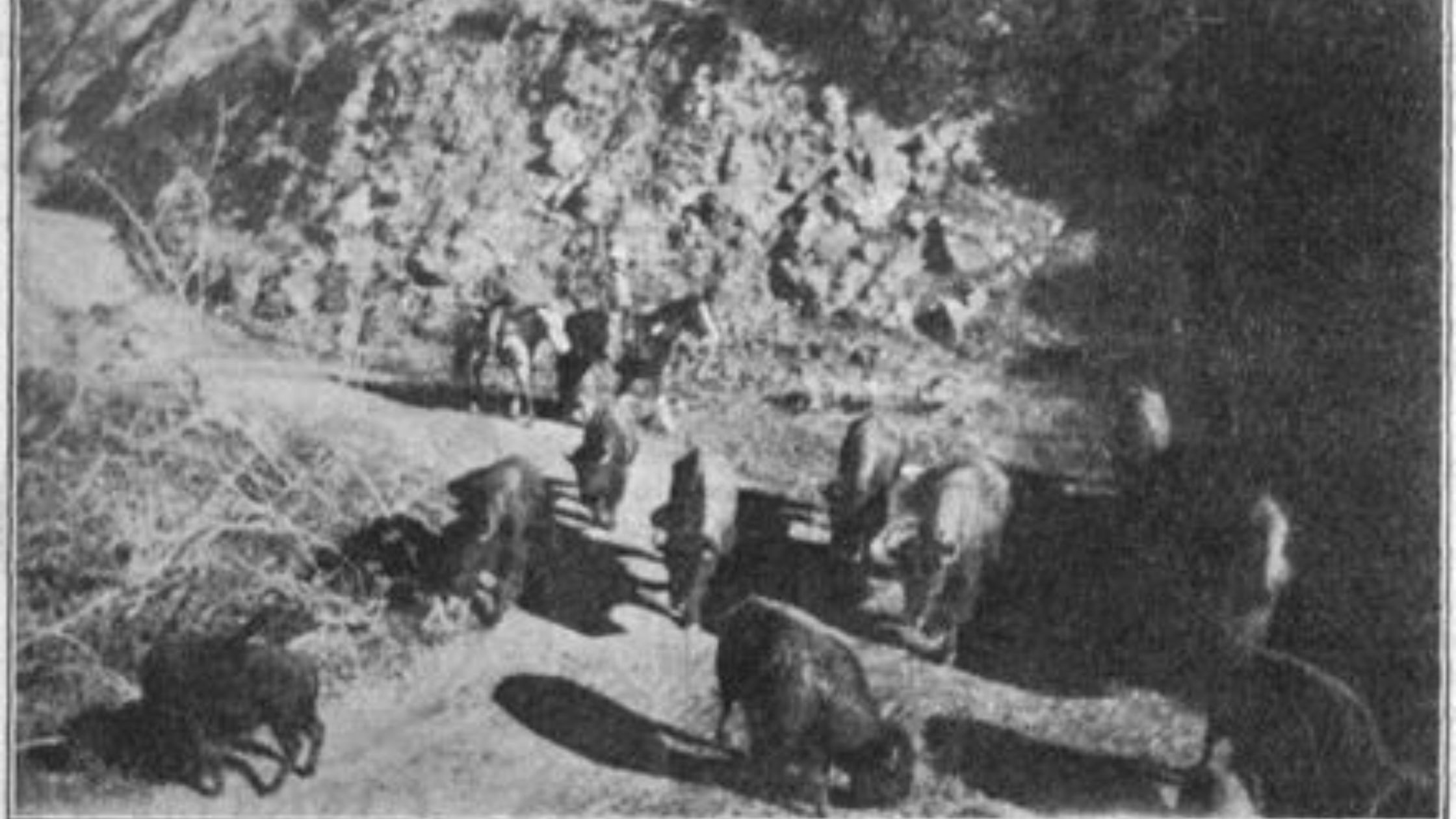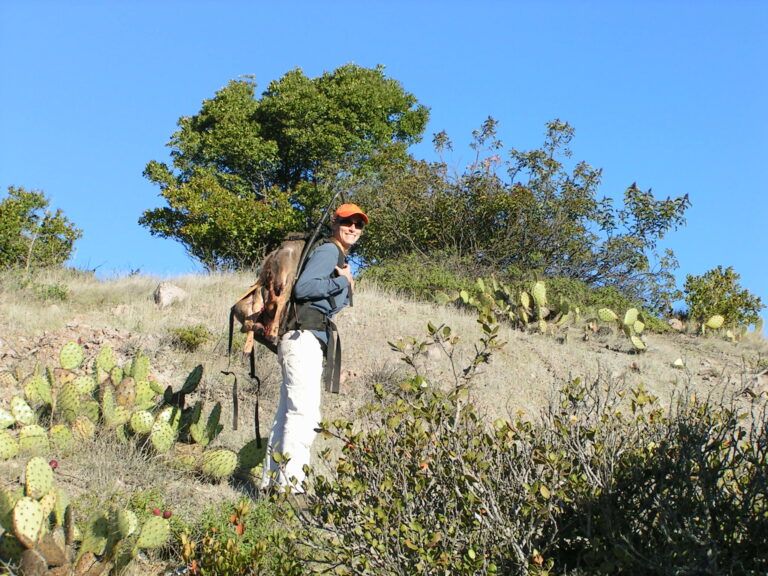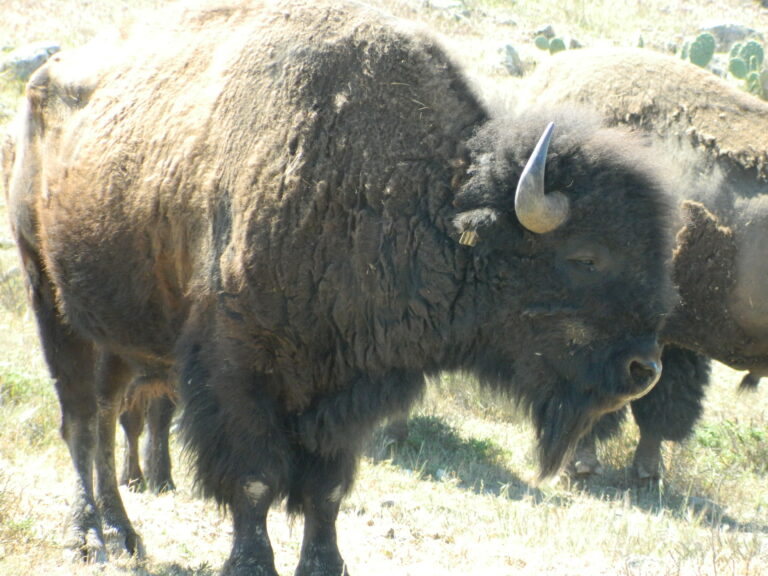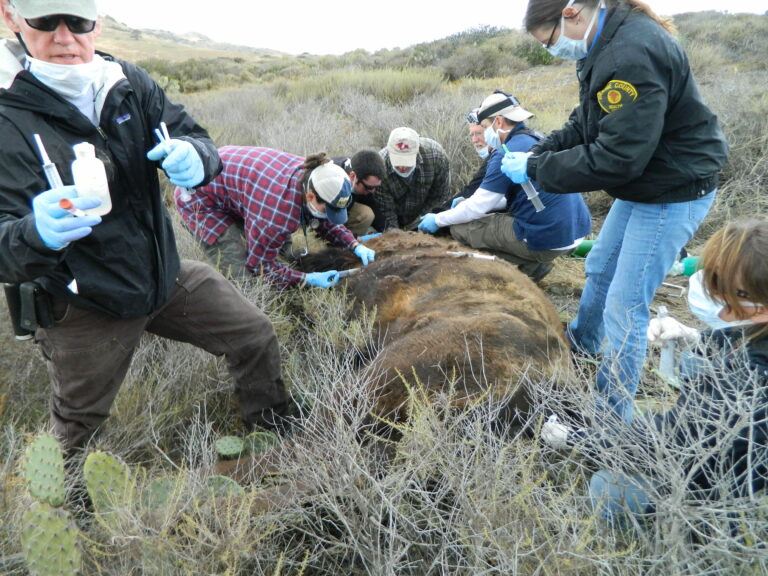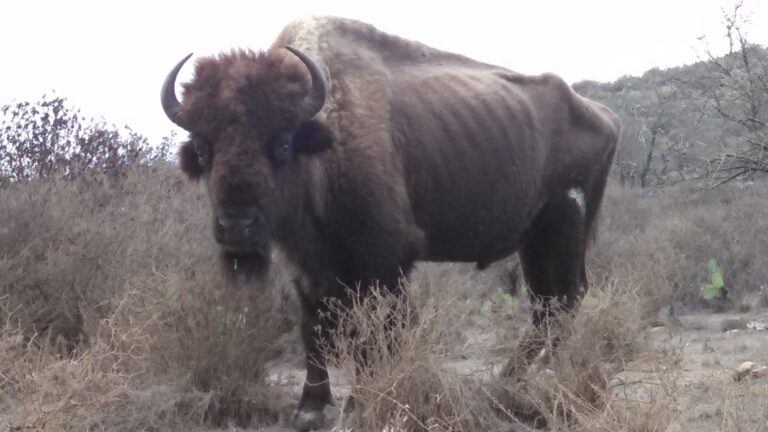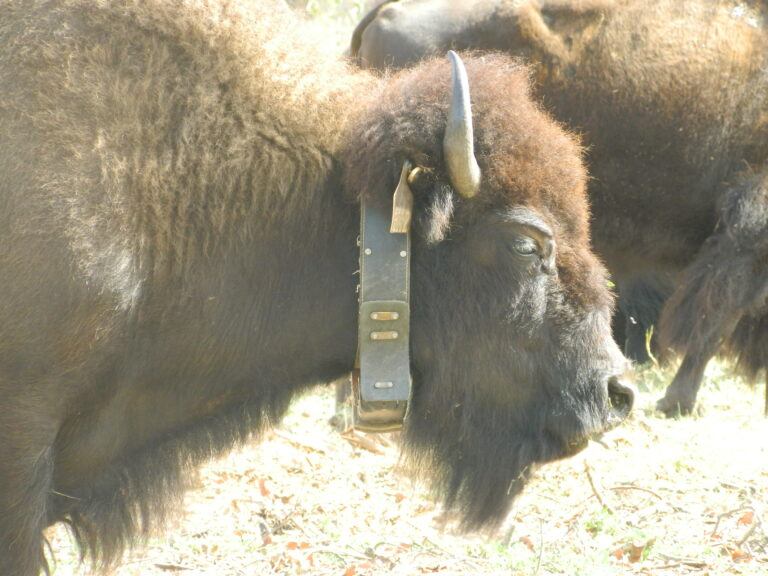The Origin of Bison on Catalina Island – The Complete Timeline of Additions
In 2003, researchers scoured historical records to identify the origin of the bison on Catalina and construct a timeline of bison additions to the Island. Despite their best efforts, much of the timeline before 1969 remained incomplete.
Due to conflicting information about where the bison came from, how many were initially introduced to the Island, and which movie they were originally slated to star in, the origin of the bison on Catalina remains unsettled.
In this article, I will attempt to update the timeline from the data and literature I accumulated while managing the bison on Catalina Island and hopefully solve the mystery once and for all.
Bison on Catalina Island – The Current Timeline – 2005
As part of a more extensive ecological study, Sweitzer et al. searched historical records and literature to piece together the complete timeline of bison additions to Catalina Island. Unfortunately, data on bison-related activities on the Island before 1969 was scarce.
Within a manuscript published in 2005, Sweitzer et al. outlined their findings in a table. Using the raw data that Sweitzer and his team accumulated and the additional literature I have collected since then, I will attempt to complete the timeline at the end of this article.
Table 1. Summary of available data on numbers of bison added to the bison herd on Catalina Island (including animals from the original introduction) from 1924 to the present. Data were compiled from Santa Catalina Island Company records, Catalina Island Conservancy records, and other documents or publications. Sweitzer et al. 2005.
| Year | Male Calves | Yearling Males | Yearling Females | Adult Males | Unknown sex/age | Totals | Source of Bison |
|---|---|---|---|---|---|---|---|
| 1924 | – | – | – | – | 14 | 14 | Unknown |
| 1934 | – | – | – | – | 9 | 9 | Unknown |
| 1934 | – | – | – | – | 1 | 1 | Unknown |
| 1968 | – | – | – | – | 1 | 1 | Unknown |
| 1969 | 15 | – | – | – | – | 15 | Gillette, Wyoming |
| 1971 | – | 7 | – | – | – | 7 | Moiese, Montana |
| 1996 | – | 2 | 4 | – | – | 6 | Palomar Mtn. California |
| 1996 | – | 6 | – | – | – | 6 | Loretta Leavitt |
| Totals | 15 | 15 | 4 | – | 25 | 59 |
The Origin of Bison On Catalina Island
The Catalina Islander – December 24, 1924
An article in The Catalina Islander, published within a week of the arrival of bison on Catalina Island, remains the primary reference for the original introduction of bison to the Island.
While the article provides details about the number of bison (14), the individual associated with the shipment of the bison to the Island (Tom White – Lasky Film Company of Hollywood) and plans to use the bison in a film the following spring, the origin of the bison is not mentioned.
Fourteen Buffalo are Free on Catalina Island
It is quite a unique experience to see a herd of buffalo, fourteen of them, on Catalina Island, But such is now the case when one ventures to the west end.
Mr. Tom White, who is connected with the Lasky Film Company of Hollywood, shipped the animals to the Isthmus last week, and they were later turned loose on the hillsides west of the Isthmus. The animals were shipped to Catalina Harbor in separate crates, slowly herded by Mr. Arnold Gillatt, and driven over to the location where they will spend the winter.
It is quite possible that the Lasky Film Company will use the buffalo in a picture during the coming spring. Several of the animals weigh 1,500 pounds each.
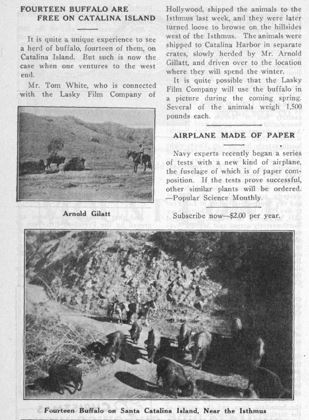
The Catalina Islander – January 21, 1925
Just four weeks later, a follow-up blurb in the Islander forecasts plans to use the bison in the film The Vanishing American.
“The Vanishing American” is the title of the new film that will be made at the Isthmus in about three weeks. It is stated that more than 300 persons will be employed on the set. The buffalo now in pasture on the west end of the Island are to be used in the picture.
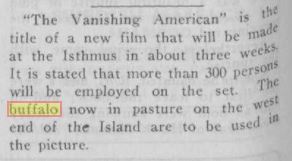
Worcester Democrat – April 18, 1925
Meanwhile, on the opposite coast, an article in the Worcester Democrat features a somewhat alternate narrative about the origin of the bison on Catalina Island, initially provided by the Philadelphia Record.
Bisons as Screen Stars
Sixteen of the eighty-six surplus bison that were subtracted from the Yellowstone herd this season have gone to California to join the movies. The Yellowstone bison have often been filmed on their native heath, and during the present season performed a leading role in the production of “The Thundering Herd.” The contingent now bound for Hollywood will be active in completing this feature. When this has been completed they will be released on Catalina Island, the Philadelphia Record says.
The animals sent out from the park went to municipalities for the most part, but some went to game preserves and forests and a few to private estates. The largest pair shipped went to Flo Ziegfeld.
The bison herd in Yellowstone Park started in 1902 with 21 animals, 18 cows from the Allard herd of western Montana and three bulls from the Goodnight herd of Texas. They multiply very rapidly, and the herd numbered 780 on August 1. There were 120 calves last spring and 100 in the spring of 1923.
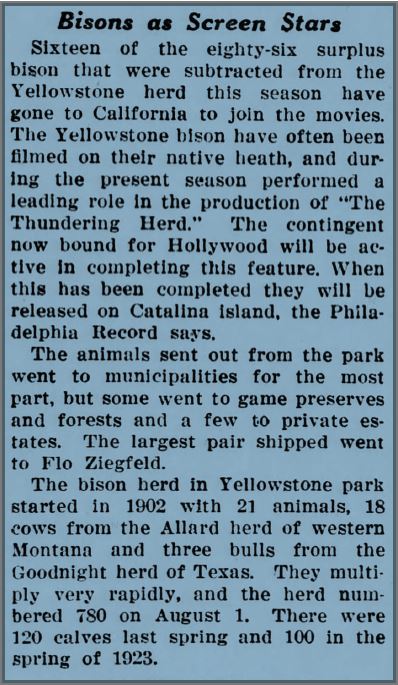
Although the number of bison listed in this article does not match the Islander article, it is possible that two of the 16 animals noted here were dropped off elsewhere before being transported to the Island or may not have survived the journey.
This article also provides a clear link between the bison on Catalina Island and Zane Grey’s production of The Thundering Herd.
The Catalina Islander – October 6, 1938
As the story is often told, the bison were brought to Catalina Island to be extras in a film, but their scenes were left on the cutting room floor. This was a reference to the manual nature in which film editing was done at the time and an attempt to explain why there was no footage of Catalina Island bison in any Zane Grey production.
This is one of two articles I found suggesting that, using a clever bit of filmmaking, Catalina Island Bison had been featured in the film The Thundering Herd, and the scene had been shot on the Island. Due to similarities in the wording, I believe the later article (September 18, 1941 – not included here) references this one.
Famed “Thundering Herd” of Buffalo Has Tripled During Island Stay
The famous buffalo stampede scene in “The Thundering Herd,” a western movie thriller made on Catalina Island in the middle twenties, thrilled spectators because it appeared to show thousands upon thousands of the almost extinct bison. Even more surprising is the fact that, today, this herd – though it has tripled in size – numbers exactly thirty-six head of buffalo!
Only twelve animals were brought to the Island by the Lasky organization, which filmed the picture. This scant number, when driven back and forth in a narrow, “I-shaped” corral, and augmented by ingenious photography, became a terrifying, thundering herd on the screen.
Today, hunters in search of wild boar or goats, hikers in the Island interior, and visitors taking the Summit and Isthmus trips often thrill to a glimpse of these majestic and privileged animals. Agents News.
While it is apparent that most of the bison footage in the movie is of a much larger herd and not filmed on Catalina, a very brief close-up shot near minute 33:56 of the film could be the one described in this article.
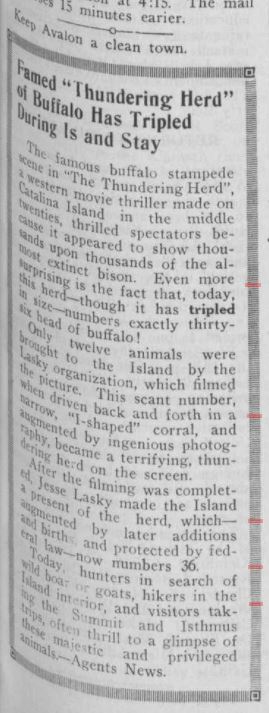
Catalina Island Bison in The Thundering Herd – Minute 33:56
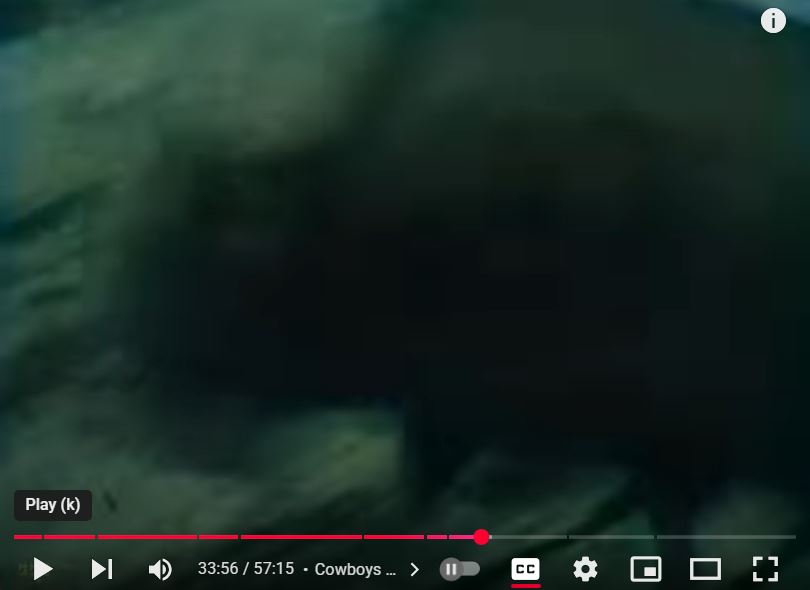
Bison Additions to Catalina Island – 1934 to Current
The Catalina Islander – November 24, 1938
In this Interesting Quiz Hour article, Earle Reinhardt Pollock, the City Engineer and City Manager of Avalon from 1932-1942, has been asked to say something about the herd of buffalo on Santa Catalina Island.
Interesting “Quiz” Hour
“It is history now that in 1924 the picture “The Covered Wagon” was made on the Island, and portions of the picture were “shot” at the Isthmus. The buffalo were used in it.
The producers agreed to leave the animals on the Island, probably on account of the cost of feeding them. This herd was composed of 18 head, and there were only four cows in the bunch, hence the increase was slow.
In 1934 Mr. Wrigley purchased 17 head from a Colorado lady who had gone broke raising buffalo. Six of these were cows. Twelve of the animals were brought to the Island, the other five going to Phoenix, Arizona.
During the past year there have been six calves dropped…Two of the buffalos have been killed by hunters with bows and arrows, and one bull fell off a cliff. There are now 32 head in the herd, and the future looks good for a yearly increase”.
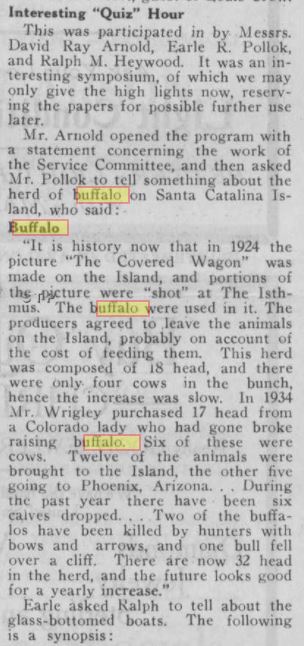
I could not confirm whether or not Earle R. Pollock was present on the Island during the initial introduction of bison in 1924. Still, he certainly appears to have been involved with, or at least in the know about, the addition of bison from Colorado in 1934.
What Movie Were Bison Brought to Catalina Island For? Answer – The Thundering Herd
The Interesting “Quiz” Hour article above is the only source I found listing The Covered Wagon as the movie the bison had been initially brought to Catalina Island for. Since Antelope Island, not Catalina, is listed as the primary filming location for The Covered Wagon, and its release date (September 8, 1924) precedes the arrival of the bison on Catalina Island, it’s an unlikely option.
The articles in the Worchester Democrat and The Catalina Islander, also listed above, provide compelling evidence that the bison were brought to the Island in association with the filming of The Thundering Herd, and they may have starred in the film ever so briefly. The movie’s release date (March 1, 1925) also aligns with the December 1924 arrival of bison on the Island.
It is possible that the Lasky Film Company considered using the bison in The Vanishing American (released February 15, 1926) since they were already on the Island, and these plans may have been made public. However, because bison are not mentioned in the book or screenplay or present in the film, it is unlikely that this movie was associated with the original introduction of bison to Catalina Island.
Los Angeles Times – January 18, 1949
This article outlines an interview with Cowboy Jack White, the ranch boss for the Catalina Island Company at the time, while he was rounding up the herd and moving them into Skull Canyon.
The article details Jack’s unique character and colorful past and places the reader in the room as he regaled his account of the original bison introduction and his involvement in a deal to bring more bison to the Island in 1934.
Buffalo Roundup Echo of the Old West
“The first group of 13 bison, all bulls and stags, were left behind in the canyon wilderness by a motion picture company.”
“Their Hollywood cowboys got ’em over here on a boat, but they couldn’t round up cattle well enough to get ’em back aboard.”
“That was in 1924, I think, that the movies left those bulls behind. And one of ’em was a big fellow, too. He weighed 1840 pounds, and I think he’s still with the herd.”
“Anyway, in 1934, Mr. Wrigley decided to build up the buffalo herd to go with the wild pigs and mountain goats and deer that have made this a real spot for wild animal hunting.”
“So I made a deal with him in Colorado, where there’s a big herd of wild ones. We bought 17 head, mostly cows. We dropped off five head at a resort hotel in Arizona to kind of make the place look western, then shipped the other 12 on to the Los Angeles Stockyards. There we packed ’em in big wooden crates and took ’em across the channel on the steamer.”
Jack details calving success at the time, the origin of the wild pigs, goats, and deer, and his plans for adding new and strange wild animals to the already fabulous fauna of the rugged backcountry.
Although there may be some disagreement between Jack White and Earle R. Pollock on the number of bison initially brought to the Island in 1924, their accounts of the addition of bison in 1934 are nearly identical.
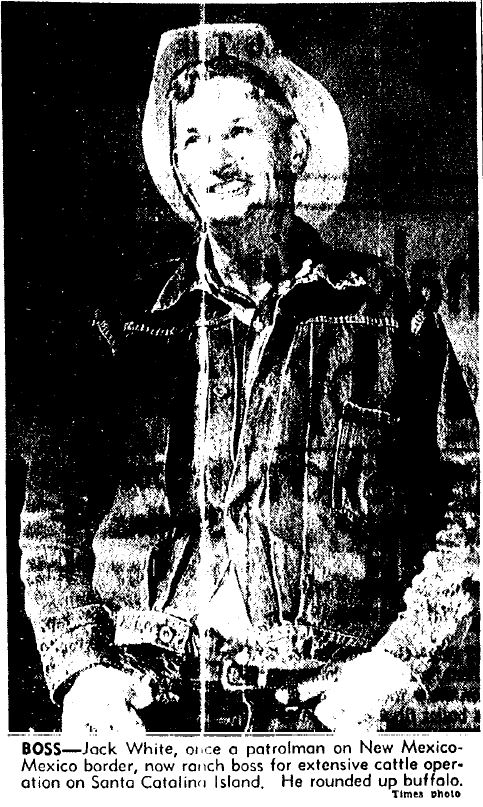
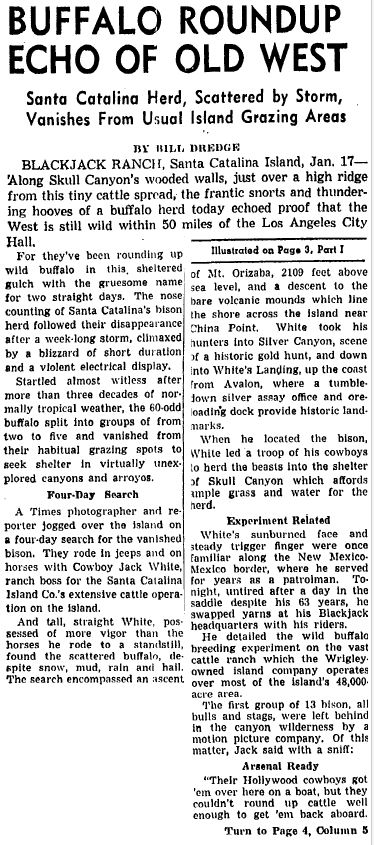
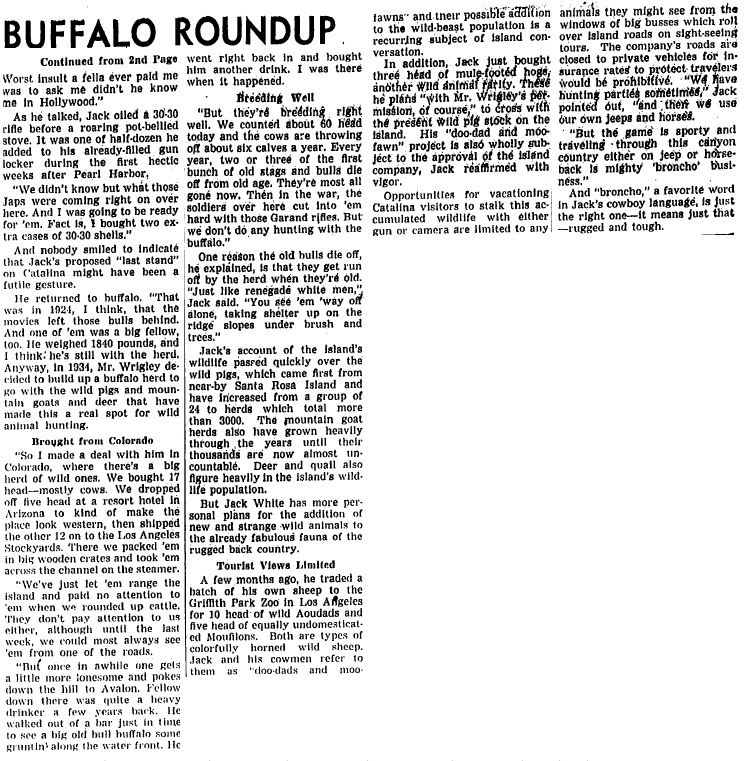
Both accounts, as reliable as they seem, however, do not align with the Catalina Island Conservancy records referenced by Sweitzer et al. 2005 which state that nine bison of unknown sex/age were brought to the Island in the fall of 1934, and one was added in December 1934 to replace an individual that had been illegally killed.
While I have found several articles confirming the incident in which two hunters killed a Catalina Island bison and a goat with a bow and arrow in 1934, and the plans to replace it, I have not found any source corroborating the addition of nine bison. I suspect that neither of these articles was available in digital form when Sweitzer et al. were constructing their timeline, and they had no option but to reference the records as they were.
Lott and Minta – 1983
Dale F. Lott was a Phycology professor at the University of California Davis from 1965-1973 and the first chair of the UC Davis Department of Wildlife and Fisheries from 1973-1979. He was a distinguished behavioral ecologist who studied bison behavior on the National Bison Range, where he grew up, and on Catalina Island.
Dale’s research laid the foundation for what we now know about bison behavior and ecology, and for those interested, his book American Bison is an excellent read.
The reason I’m introducing you to Dale Lott is that one of his scientific publications (Random Individual Association and Social Group Instability in American Bison (Bison Bison)) mentions the addition of six yearling bulls to Catalina Island in 1969, followed by seven yealing bulls in 1970.
Although the source of information appears to be Douglas Propst, the president of the Catalina Island Conservancy at the time, there is no mention of where these bison came from.
National Bison Association – Buffalo! – 1985
Part of this article highlights Catalina Island as an ideal location to learn about the management of closed herds and the history of the island herd, provided by Douglas Propst during the Association’s spring meeting held on the Island in 1981.
Opportunities in Managing Closed Herds
Eleven original plains buffalo were brought there (Catalina Island) in 1924 for the filming of a Zane Gray Western. They declined to leave after becoming movie stars.
The herd was augmented with 14 animals from the Sherwin herd in Logan, Colorado, in 1934 (probably also the source of the original animals).
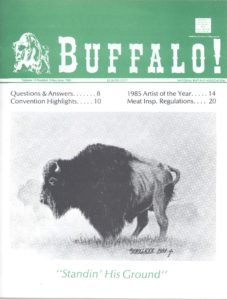
New blood was introduced with 15 bull calves from the Durham (Gillette, Wyoming) herd in 1969 and 7 bull calves from Moiese, Montana, National Bison Range in 1970.
Although there are some discrepancies between this article and earlier sources concerning the original introduction of bison in 1924 and the number added in 1934, the details associated with bison additions in 1969 and 1970 appear to reference the actual records.
The Conservancy’s records also note photographs from 1971 that show seven bull calves brought to the Island from the National Bison Range. I think these were the same individuals indicated in 1970, and an error may have been made in the records or the dating of the photographs.

The Most Recent Bison Additions According to the Records – 1996
On September 11, 1996, the Catalina Island Conservancy traded six yearling cows to Arthur H. Voss for two yearling bulls and four yearling cows. In his retirement, Arthur H. Voss built the 376-acre Ahvsan Ranch on Palomar Mountain, California, where he raised bison, cattle, and a variety of exotic animals. Arthur sold the property in 2005, just two years prior to his passing. I could not find any records of where Arthur had acquired his bison from.
On October 22, 1996, the Conservancy traded six cow calves to Loretta Leavitt for six yearling bulls. There does not appear to be any information in the records identifying who Loretta Leavitt was, her connection to the Island, where her ranch was located, or where her bison had originated from.
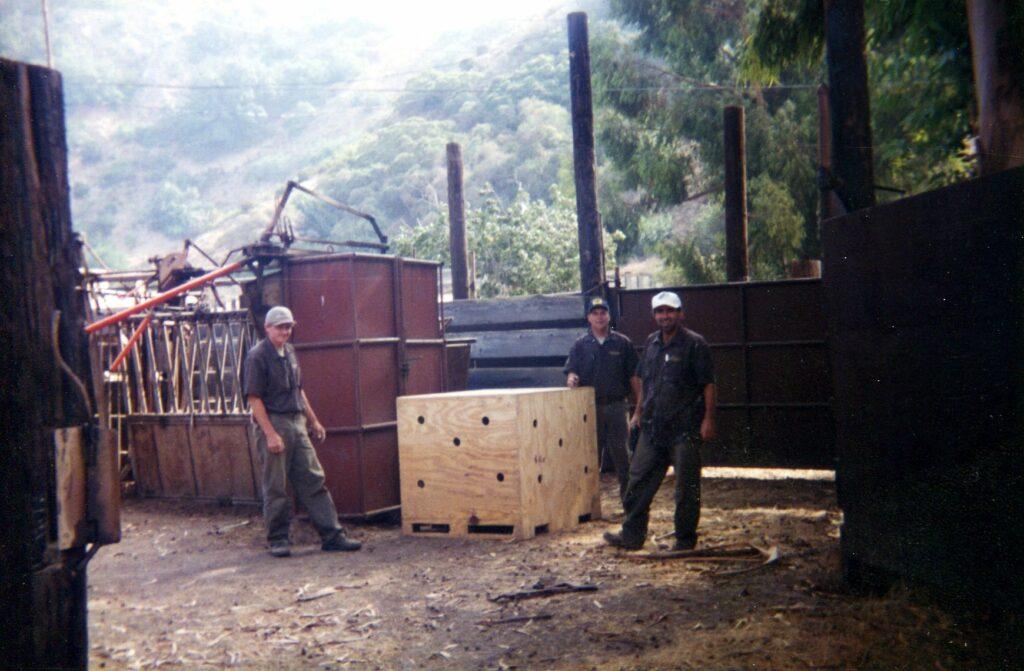
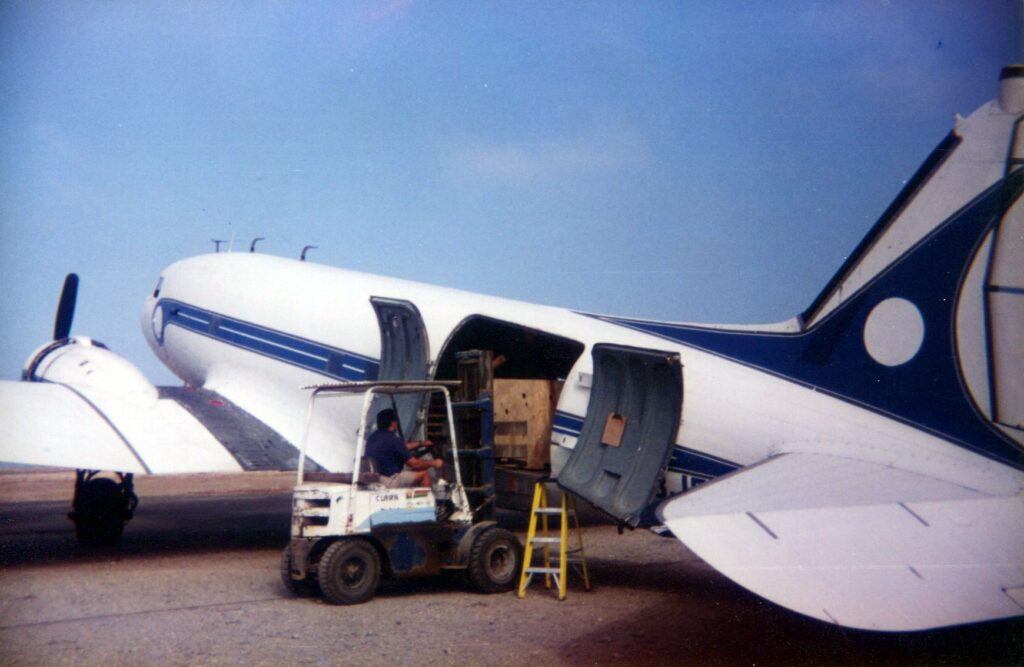
Cattle DNA Detected in Bison on Catalina Island – Vogel et al. 2007
Vogel et al.’s scientific paper – Detection of Mitochondrial DNA From Domestic Cattle in Bison on Santa Catalina Island changed the narrative and made national news. According to this research, of the 98 Catalina bison sampled in 2004, 44 (45%) had domestic cattle mitochondrial DNA.
These findings contradicted the long-held, though somewhat misguided, belief that the bison on Catalina Island were genetically pure. The kicker, however, was that Vogel et al., again referencing Doug Propst, listed the Sherwin Ranch in Colorado as the likely source of the 14 bison initially brought to Catalina Island in 1924.
The Sherwin Ranch had originated from the Goodnight Ranch in Texas, and Charles Goodnight was well known for his efforts to crossbreed bison with domestic cattle. As noted above, multiple sources link the Sherwin Ranch to the addition of bison in 1934, which would account for the introduction of cattle genes to the Catalina Herd. The assumption that the original 14 bison also came from the Sherwin Ranch, however, appears to have been initiated and perpetuated by Doug Propst.
Bison on Catalina Island – The Updated Timeline – 2023
Although I wasn’t able to fill in the timeline completely, the literature supports the narrative that the 14 bison introduced to Catalina Island in 1924 originated from Yellowstone National Park and were brought to the Island to support the filming of The Thundering Herd.
Based on the literature, I also believe that cattle gene introgression within the Catalina herd originated with the addition of 12 bison from the Sherwin Ranch in 1934 and potentially from subsequent additions.
| Year | Number of Bison | Source of the Bison | Reference |
|---|---|---|---|
| 1924 | 14 | Yellowstone National Park, Wyoming | The Catalina Islander Dec 24, 1924, Worcester Democrat Apr 18, 1925, The Catalina Islander Oct 6, 1938. |
| 1934 | 12 (mostly females) | Sherwin Ranch, Colorado | The Catalina Islander Nov 24, 1938, Jack White – LA Times Jan 18, 1949, Doug Propst – Bison Association Publication – Buffalo! 1985 |
| 1934 | 1 (male) | Unknown | A replacement bison for one that had been illegally killed. Sweitzer et al. 2005 – Historical records. |
| 1968 | 1 | Unknown | A replacement bison for one that had been illegally killed. Sweitzer et al. 2005 – Historical records. |
| 1969 | 15 (male calves) | Durham Herd, Gillette, Wyoming | Doug Propst – Bison Association Publication – Buffalo! 1985, Lott and Minta 1983. |
| 1970 | 7 (yearling males) | National Bison Range, Moiese, Montana | Doug Propst – Bison Association Publication – Buffalo! 1985, Lott and Minta 1983. |
| 1996 | 6 (2 yearling males & 4 yearling females) | Ahvsan Ranch (Arthur H. Voss) Palomar Moutain, California | Sweitzer et al. 2005 – Catalina Island Conservancy Records |
| 1996 | 6 (yearling males) | Loretta Leavitt | Sweitzer et al. 2005 – Catalina Island Conservancy Records |
| Total | 62 |
Do you agree with my updated timeline? Have you found any references that support or contradict my results? Please feel free to comment below and share your thoughts.
Thank you for visiting WildlifeDetections.com. Check back often for new content or subscribe to my newsletter to receive updates on new articles, and if you have enjoyed this post, please don’t hesitate to share.

